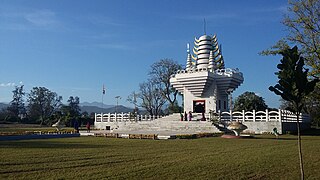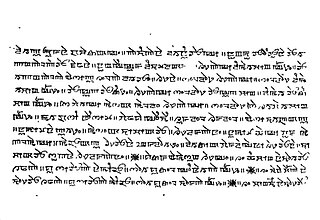Related Research Articles
Indian literature refers to the literature produced on the Indian subcontinent until 1947 and in the Republic of India thereafter. The Eighth Schedule to the Constitution of India has 22 officially recognised languages. Sahitya Akademi, India's highest literary body, also has 24 recognised literary languages.

Meitei also known as Manipuri, is a Tibeto-Burman language of northeast India. It is the official language and the lingua franca of Manipur and an additional official language in four districts of Assam. It is one of the constitutionally scheduled official languages of the Indian Republic. Meitei is the most widely-spoken Tibeto-Burman language of India and the third most widely spoken language of northeast India after Assamese and Bengali. There are 1.76 million Meitei native speakers in India according to the 2011 census, 1.52 million of whom are found in the state of Manipur, where they represent the majority of its population. There are smaller communities in neighbouring Indian states, such as Assam (168,000), Tripura (24,000), Nagaland (9,500), and elsewhere in the country (37,500). The language is also spoken by smaller groups in neighbouring Myanmar and Bangladesh.

The Meitei people, also known as Meetei, Manipuri people, are an Tibeto-Burman ethnic group native to Manipur. They form the largest and dominant ethnic group of Manipur in Northeast India. They speak the Meitei language, one of the 22 official languages of the Republic of India and the sole official language of Government of Manipur. The Meiteis primarily settled in the Imphal Valley region in modern-day Manipur, though a sizeable population has settled in the other Indian states of Assam, Tripura, Nagaland, Meghalaya, and Mizoram. There is also a notable presence of Meitei people in the neighbouring countries of Myanmar and Bangladesh. The Meitei ethnic group represents about 53% of Manipur's population.

The Kangla with diacritic Kanglā, officially known as the Kangla Fort, is an old fortified palace at Imphal, in the Manipur state of India. It was formerly situated on both sides of the bank of the Imphal River, now remaining only on the western side in ruined conditions. Kangla means "the prominent part of the dry land" in old Meetei. It was the traditional seat of the past Meetei rulers of Manipur.

Meitei literature, also known as Manipuri literature, is literature written in the Meitei language of Manipur. An ancient institution of learning, the Luwang Nonghumsang, later known as the Pandit Loishang, collected sources of indigenous Meitei knowledge and philosophy until the 18th century. Writing by Meiteis is assumed to go back to the Kingdom of Kangleipak in the early 12th century. The Meitei script is a Brahmic abugida. It is known only from the Puya manuscripts discovered in the first half of the 20th century. Manuscripts of the 18th and 19th centuries were written using the Bengali alphabet. The existence of the Meitei script in the 15th-century hinges on the authenticity of an inscription dated to the reign of Senbi Kiyamba. The first printed Manipuri book, Manipurer Itihas, appeared in 1890 from the Baptist Mission Press, Calcutta. Though the kings of Manipur had established contact with the British from the middle of the eighteenth century onward the real impact of the contact came much later. Johnstone Middle English School, based on the western system of education, was started in 1885 at Imphal, and in 1891 Manipur lost its independence to the British. British domination facilitated the introduction of new systems in the civil, political and educational spheres, which hastened the process of modernization in Manipur, exposed as it was to new ideas and influences.

The Manipuri Sahitya Parishad is a literary council dedicated to the active promotion and the development of literary works in the Meitei language in India. in national as well as international levels. It has its branches in the Manupur cities of Imphal, Jiribam, Bishnupur and Thoubal inside Manipur and in Tripura and Meghalaya in Assam.

Nongshaba is a lion god in Sanamahism and Meitei mythology. He is also regarded as a king of the gods. He is credited with producing light in the primordial universe and is regarded as the maker of the sun. He is worshipped by the people of both the Ningthouja clans as well as the Moirang clans. Nongshaba was worshipped by the people of Moirang clan as a lineage deity and regarded as the father of the god Thangching. He is the greatest of the Umang Lais but he made his only son Thangching the chief deity of Moirang.

King Loiyumba, also known as Meidingu Loiyumpa, was a Meitei monarch and a ruler of Kangleipak kingdom. He was the first king to order a written constitution in the 11-12th century CE which is known as the Loiyumpa Silyel .

Yumjao Leima or Yumjao Lairembi or Yumjao Lairemma is the mother goddess of house, household, royalty, rule and power in Meitei mythology and religion. She is designated as the all time ruling Queen Mother. Legend says she assumes a human form in white clothes and blesses kings. She is one of the divine incarnations of Leimarel Sidabi.

Leima Lainaotabi is a goddess in Sanamahism, the indigenous religion of Manipur. She is the youngest wife of God Thongalel of the underworld kingdom. Thongalel sent her to be the wife of Poireiton, her brother-in-law. Lainaotabi gave birth to a son with Poireiton. Her legend says she made the first clay pot. She was worshipped by the people of Ashangbam clan.

Pureiromba is a God in Meitei mythology and religion. He is the giver of rain and agricultural prosperity. He is one of the major Umang Lai deities. He is the Ancestor God of the Angom clan of the Meitei ethnicity.

Phou Ningthou is a deity in Sanamahism, the indigenous religion of Manipur). He is the God and the divine male personification of the agriculture, crops, fertility, grains, harvesting, rice paddies, rice and wealth. He is the consort of Phouoibi (Phouleima), the goddess of crops and agricultural fertility.
Nongmaiching Hill or Nongmaijing Hill, also known as the Selloi Langmai Ching, is a hill in the Imphal Valley in Manipur, India. It rises to the east of the Imphal City with a peak at an elevation of 5,133 feet (1,565 m) above sea level. It is a holy pilgrimage site for the Meitei people. In Meitei mythology and religion (Sanamahism), it is a sacred mountain and the abode of God Nongpok Ningthou and Goddess Panthoibi. In Meitei folklore, the Nongmaiching is described as the hill that produces "the seven days of a week".

The culture of Meitei civilization evolved over thousands of years, beginning in Ancient Kangleipak, continuing most notably into Medieval Kangleipak, while influencing the neighboring states and kingdoms, till present times.
Pengsiba or Pengshiba was a ruler of ancient Manipur. He was a successor of Khui Ningomba and the predecessor of Kaokhangba. In the 4th century AD, during the reign of his era, Manipuri traders reached out on horseback to upper Burma and China. He is one of the nine kings who are associated with the design of a historic flag.
Meidingu Naokhamba was a ruler of Ancient Manipur. He is the successor of Kaokhangba and the predecessor of Naophangba. During his reign, Manipuri traders reached out on horseback to upper Burma and China. Besides the Cheitharol Kumbaba and the Ningthourol Lambuba, he is also mentioned in the Chengleiron. Naokhamba abducted the wife of King Thangyi Khongjromba of the Chenglei tribe when she was heavily pregnant. Later, she had a son named "Naophang Ahanba". During his reign, Chingjen Naran Panggalba, the king of the Chengleis left Kangleipak for westward lands.

The Loiyumpa Silyel, also termed as the Loyumpa Silyel or the Loiyumpa Shilyel or the Loyumpa Shilyel or the Loyumba Sinyen, is an 11th-12th century ancient Meitei language written constitution, regulated in the Ancient Kangleipak during the rule of King Loiyumba. In 1110 CE, its format was finalised from a promulgation of the proto-constitution, drafted in 429 CE by King Naophangba. Historically, it is the first written constitution, and one of the well recorded Ancient Meitei language texts of the kingdom. It was replaced by the Manipur State Constitution Act 1947, that was functional until Manipur was merged into Republic of India on October 15, 1949.

Women have significant roles in different elements of Meitei culture, including Meitei dances, Meitei festivals, Meitei folklore, Meitei folktales, Meitei literature, Meitei mythology, Meitei religion, etc.

Ancient Meitei literature, also termed as Old Manipuri literature, is literature written in the Old Manipuri language from the earliest texts until the time of King Pamheiba. All the ancient Meitei literary works are written in the traditional Meitei script. The ancient Meitei language texts, written in Meitei script, are conventionally termed as "the puyas".
References
- ↑ George, K. M. (1997). Masterpieces of Indian Literature: Manipuri, Marathi, Nepali, Oriya, Punjabi, Sanskrit, Sindhi, Tamil, Telugu & Urdu. National Book Trust. ISBN 978-81-237-1978-8.
- 1 2 Ray, Asok Kumar; Chakraborty, Satyabrata (2008). Society, Politics, and Development in North East India: Essays in Memory of Dr. Basudeb Datta Ray. Concept Publishing Company. ISBN 978-81-8069-572-8.
- ↑ Sana, Raj Kumar Somorjit (2010). The Chronology of Meetei Monarchs: From 1666 CE to 1850 CE. Waikhom Ananda Meetei. ISBN 978-81-8465-210-9.
- ↑ Sanajaoba, Naorem (1993). Manipur: Treatise & Documents. Mittal Publications. ISBN 978-81-7099-399-5.
- ↑ Sanajaoba, Naorem (1993). Manipur: Treatise & Documents. Mittal Publications. ISBN 978-81-7099-399-5.
- ↑ Devi, Lairenlakpam Bino (2002). The Lois of Manipur: Andro, Khurkhul, Phayeng and Sekmai. Mittal Publications. ISBN 978-81-7099-849-5.
- ↑ Sanajaoba, Naorem (1988). Manipur, Past and Present: The Heritage and Ordeals of a Civilization. Mittal Publications. ISBN 978-81-7099-853-2.
- ↑ Bahadur, Mutua (1988). Jewelleries of Manipur. Mutua Museum.
- ↑ Tensuba, Keerti Chand (1993). Genesis of Indian Tribes: An Approach to the History of Meiteis and Thais. Inter-India Publications. ISBN 978-81-210-0308-7.
- ↑ Brara, N. Vijaylakshmi (1998). Politics, Society, and Cosmology in India's North East. Oxford University Press. ISBN 978-0-19-564331-2.
- ↑ Irene, Salam (2010). The Muslims of Manipur. Gyan Publishing House. ISBN 978-81-7835-828-4.
- ↑ "Islam in India - Wikipedia". en.m.wikipedia.org. Retrieved 2021-08-31.